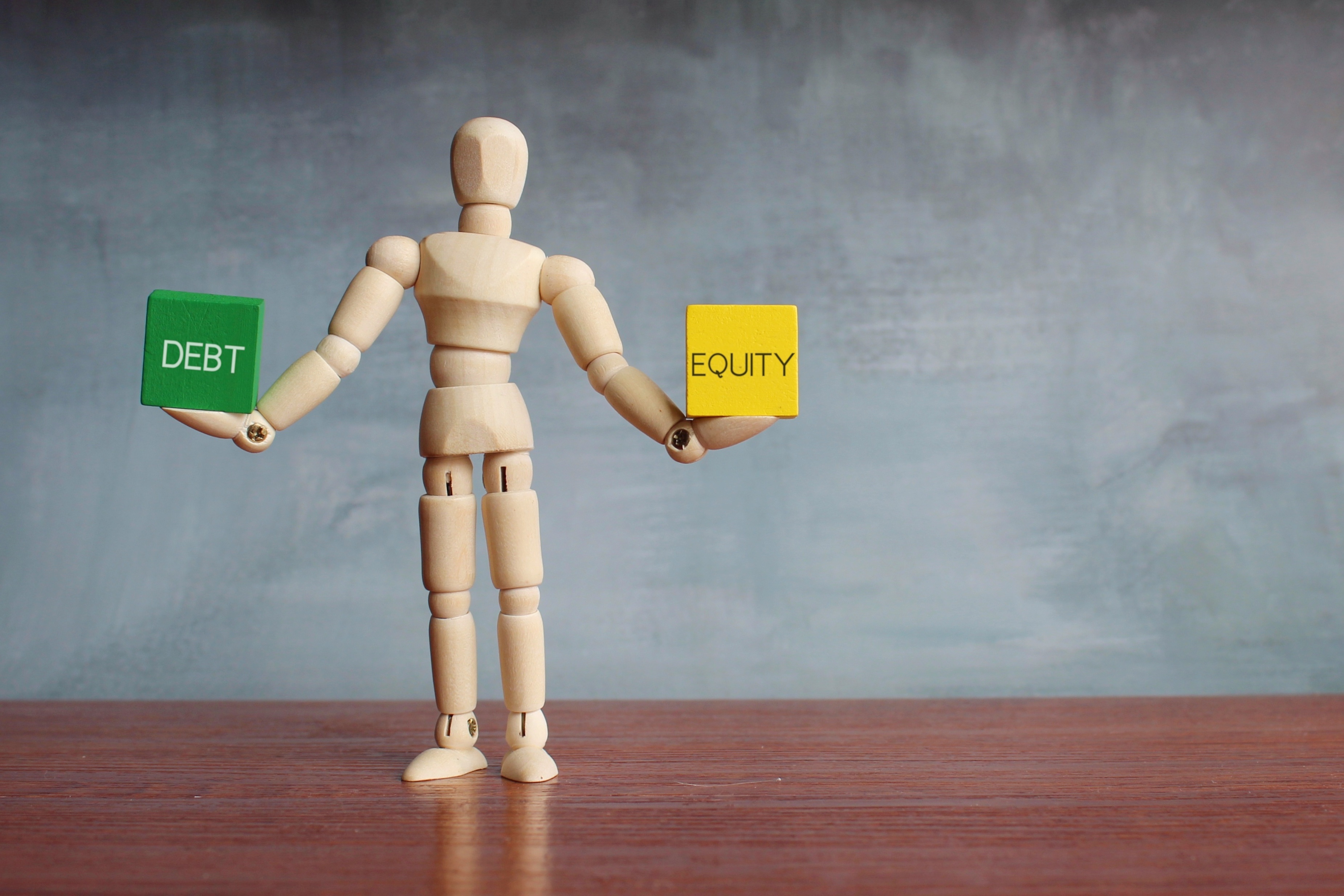What Is a Debt-to-Equity Ratio, and How Do Investors Interpret the Number?
A debt-to-equity ratio is a way to measure a company's financial position. What does the ratio tell us? How do investors use it?


In nutrition science, there's a theory of metabolic typing that determines what category of macronutrient — protein, fat, carbs or a mix — you run best on.
The debt-to-equity ratio is the metabolic typing equivalent for businesses. It can tell you what type of funding — debt or equity — a on which a business primarily runs.
"Observing a company's capital structure is very important, as the cost of capital has increased significantly in the aftermath of the Federal Reserve's steep rate hikes," says Stash Graham, managing director at Graham Capital Wealth Management.
From just $107.88 $24.99 for Kiplinger Personal Finance
Become a smarter, better informed investor. Subscribe from just $107.88 $24.99, plus get up to 4 Special Issues

Sign up for Kiplinger’s Free Newsletters
Profit and prosper with the best of expert advice on investing, taxes, retirement, personal finance and more - straight to your e-mail.
Profit and prosper with the best of expert advice - straight to your e-mail.
"As debt becomes more expensive to service," Graham says, "companies with larger than average debt burdens must allocate more cash towards paying down debt instead of returning that cash to shareholders through cash dividends or share repurchases."
Here's what you need to know about the debt-to-equity ratio and what it reveals about a company's capital structure to make better investing decisions.
Defining the debt-to-equity ratio
The debt-to-equity ratio is a financial equation that measures how much debt a company has relative to its shareholders' equity. It can signal to investors whether the company leans more heavily on debt or equity financing.
A company with a high debt-to-equity ratio uses more debt to fund its operations than a company with a lower debt-to-equity ratio.
The debt-to-equity ratio also gives you an idea of how solvent a company is, says Joe Fiorica, head of Global Equity Strategy at Citi Global Wealth.
"Solvency," Fiorica explains, "refers to a firm's ability to meet financial obligations over the medium to long term."
Why is the debt-to-equity ratio important?
If you're an equity investor, you should care deeply about a firm's ability to meet its debt obligations, because common stockholders are the last to receive payment in the event of a company liquidation.
"Once bond principal and interest payments are made, the leftover profits are retained by shareholders and can be paid out in the form of dividends or buybacks," Fiorica says.
"Therefore," the analyst notes, "a lower debt-to-equity ratio implies that equity holders have a greater chance of benefiting from growth in retained earnings over time and a lower risk of default."
How to calculate the debt-to-equity ratio
You can calculate the debt-to-equity ratio by dividing shareholders' equity by total debt.
For example, if a company's total debt is $20 million and its shareholders' equity is $100 million, then the debt-to-equity ratio is 0.2. This means that for every dollar of equity, the company has 20 cents of debt, or leverage.
While using total debt in the numerator of the debt-to-equity ratio is common, a more revealing method would use net debt, or total debt minus cash and cash equivalents the company holds.
"The thought is this company can use that cash immediately to pay down debt if wanted," Graham says. "As such, an investor should give the company credit for any money at hand that it has on its balance sheet and subtract that from total debt."
You could also replace the book equity found on the balance sheet with the market value of the company's equity, called enterprise value, in the denominator, he says.
"The book value is beholden to many accounting principles that might not reflect the company's actual value."
What is a good debt-to-equity ratio?
"A good debt-to-equity ratio depends on the type of business," Graham says.
Does the company generate consistent operating cash flow? Is the company cyclical or non-cyclical in structure?
"Ideally, you want companies to have more equity than debt," he says.
A good debt-to-equity ratio also varies by industry.
For example, utilities tend to be a highly indebted industry, whereas energy was the lowest in the second quarter of 2025.
These ratios can fluctuate over time even within industries. The energy industry, for example, only recently shifted to a lower debt structure, Graham says.
"In the last six years, you have seen this industry navigate two rounds of bankruptcy waves where companies in the energy sector had to navigate highly leveraged balance sheets with meager energy prices," he says. "Today, we are witnessing energy companies with strong balance sheets. Management teams have learned the lessons of prior years and have retired a lot of outstanding debt."
When debt-to-equity ratios vary greatly within an industry, it can be a "feast for stock pickers who can seek out companies with lower levels of debt while avoiding the over-levered firms that sit in passive indices," Fiorica says.
Final notes on debt-to-equity ratios
"In the world of stock and bond investing, there is no single metric that tells the entire story of a potential investment," Fiorica says. "While debt-to-equity ratios are a useful summary of a firm's use of financial leverage, it is not the only signal for equity analysts to focus on."
A firm that uses its leverage to capitalize on a high-return project will likely outperform one that uses very little debt but sits in an unfavorable position in its industry, he says.
At Citi, they "consider not only leverage, but prospective earnings growth, valuation, dividend payouts and liquidity position, as well as qualitative factors like management quality and business position," Fiorica says.
You would be wise to do the same with your prospective investments.
Related content
Profit and prosper with the best of Kiplinger's advice on investing, taxes, retirement, personal finance and much more. Delivered daily. Enter your email in the box and click Sign Me Up.

Coryanne Hicks is an investing and personal finance journalist specializing in women and millennial investors. Previously, she was a fully licensed financial professional at Fidelity Investments where she helped clients make more informed financial decisions every day. She has ghostwritten financial guidebooks for industry professionals and even a personal memoir. She is passionate about improving financial literacy and believes a little education can go a long way. You can connect with her on Twitter, Instagram or her website, CoryanneHicks.com.
-
 What to expect from the global economy in 2026
What to expect from the global economy in 2026The Kiplinger Letter Economic growth across the globe will be highly uneven, with some major economies accelerating while others hit the brakes.
-
 What You Need to Do With Your 401(k) Before 2025 Is Over
What You Need to Do With Your 401(k) Before 2025 Is OverBefore 2025 ends, check your 401(k) contributions, investments, and catch-up eligibility to lock in this year’s tax savings and employer match.
-
 3 Year-End Tax Moves You Can't Afford to Miss
3 Year-End Tax Moves You Can't Afford to MissDon't miss out on this prime time to maximize contributions to your retirement accounts, do Roth conversions and capture investment gains.
-
 I'm a Tax Attorney: These Are the Year-End Tax Moves You Can't Afford to Miss
I'm a Tax Attorney: These Are the Year-End Tax Moves You Can't Afford to MissDon't miss out on this prime time to maximize contributions to your retirement accounts, do Roth conversions and capture investment gains.
-
 I'm an Investment Adviser: This Is the Tax Diversification Strategy You Need for Your Retirement Income
I'm an Investment Adviser: This Is the Tax Diversification Strategy You Need for Your Retirement IncomeSpreading savings across three "tax buckets" — pretax, Roth and taxable — can help give retirees the flexibility to control when and how much taxes they pay.
-
 Dow Rises 497 Points on December Rate Cut: Stock Market Today
Dow Rises 497 Points on December Rate Cut: Stock Market TodayThe basic questions for market participants and policymakers remain the same after a widely expected Fed rate cut.
-
 Could an Annuity Be Your Retirement Safety Net? 4 Key Considerations
Could an Annuity Be Your Retirement Safety Net? 4 Key ConsiderationsMore people are considering annuities to achieve tax-deferred growth and guaranteed income, but deciding if they are right for you depends on these key factors.
-
 I'm a Financial Pro: Older Taxpayers Really Won't Want to Miss Out on This Hefty (Temporary) Tax Break
I'm a Financial Pro: Older Taxpayers Really Won't Want to Miss Out on This Hefty (Temporary) Tax BreakIf you're age 65 or older, you can claim a "bonus" tax deduction of up to $6,000 through 2028 that can be stacked on top of other deductions.
-
 JPMorgan's Drop Drags on the Dow: Stock Market Today
JPMorgan's Drop Drags on the Dow: Stock Market TodaySmall-cap stocks outperformed Tuesday on expectations that the Fed will cut interest rates on Wednesday.
-
 Meet the World's Unluckiest — Not to Mention Entitled — Porch Pirate
Meet the World's Unluckiest — Not to Mention Entitled — Porch PirateThis teen swiped a booby-trapped package that showered him with glitter, and then he hurt his wrist while fleeing. This is why no lawyer will represent him.
-
 Smart Business: How Community Engagement Can Help Fuel Growth
Smart Business: How Community Engagement Can Help Fuel GrowthAs a financial professional, you can strengthen your brand while making a difference in your community. See how these pros turned community spirit into growth.